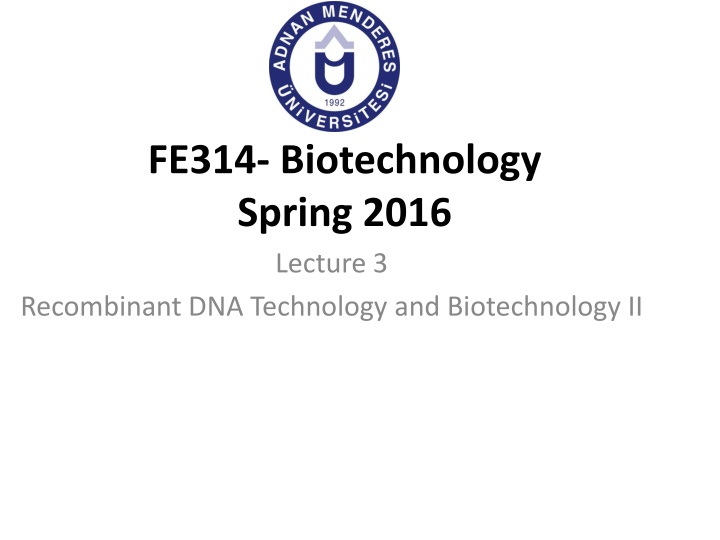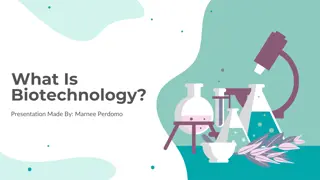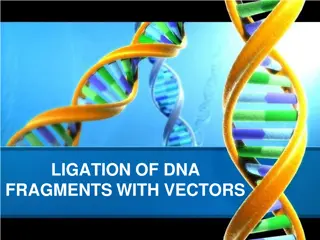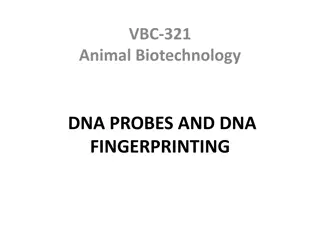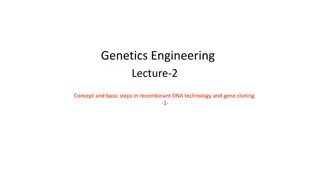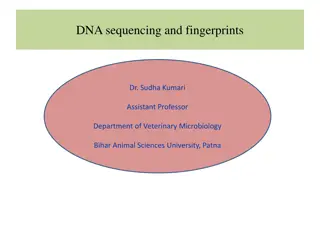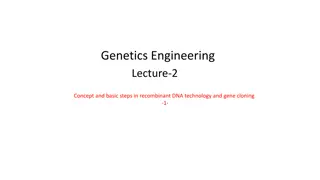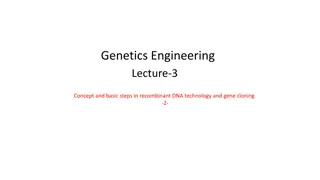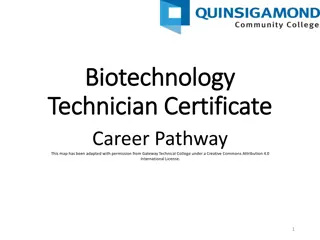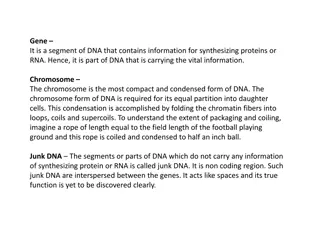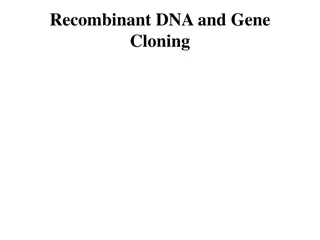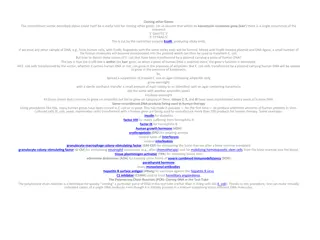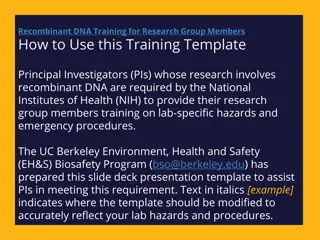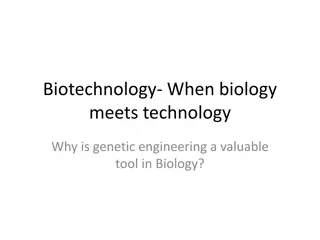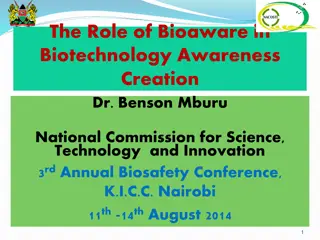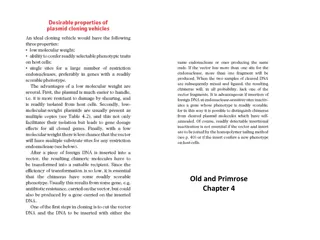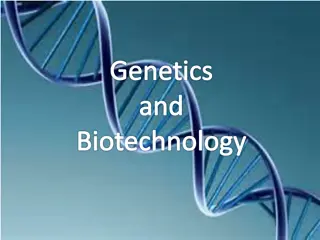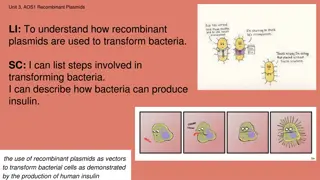Applications of Recombinant DNA Technology in Biotechnology
"Explore the various applications of recombinant DNA technology in biotechnology, including insulin production for diabetes, enzyme production in food biotechnology, and the development of Golden Rice. Understand the process of insulin production using recombinant DNA technology and the significance of insulin in managing diabetes mellitus."
Download Presentation

Please find below an Image/Link to download the presentation.
The content on the website is provided AS IS for your information and personal use only. It may not be sold, licensed, or shared on other websites without obtaining consent from the author.If you encounter any issues during the download, it is possible that the publisher has removed the file from their server.
You are allowed to download the files provided on this website for personal or commercial use, subject to the condition that they are used lawfully. All files are the property of their respective owners.
The content on the website is provided AS IS for your information and personal use only. It may not be sold, licensed, or shared on other websites without obtaining consent from the author.
E N D
Presentation Transcript
FE314- Biotechnology Spring 2016 Lecture 3 Recombinant DNA Technology and Biotechnology II
Some applications of recombiant DNA technology in Biotechnology *Diabates-Insulin production(medical biotechnology) *Enzyme production (Food Biotechnology) *Golden rice(Agricultural and Food Biotechnology)
Example: Production of Insulin (Medical Biotechnology)
Diatebes and insulin requirement Understand what Diabetes is and how it affects the person Understand how insulin can be produced by recombinant DNA technology
Diabetes mellitus (DM), Diabetes mellitus (DM), commonly referred to as diabetes, is a group of metabolic diseases in which there are high blood sugar levels over a prolonged period. Diabetes is due to either the pancreas not producing enough insulin or the cells of the body not responding properly to the insulin produced
Insulin what is it exactly? A hormone (chemical messenger) that allows glucose to pass from the blood into your cells.
Recombinant DNA technology Joining together DNA molecules from two different species. This is then inserted into a host organism which can produce new genetic combinations that are useful to us
Bacteria E. coli Transformation
Key words Sticky ends Restriction enzyme Isolated gene Plasmid Recombinant plasmid Vector DNA ligase Transformation Steps (not in order) 1.The insulin gene is inserted into the bacterial plasmid using DNA ligase 2.The gene for insulin is isolated and removed from human DNA leaving it with sticky ends 3.The recombinant plasmid is taken up by the bacteria by transformation 4.A plasmid from the bacteria E coli is removed and cut open using restriction enzymes 5.The bacteria reproduces, making copies of the gene each time, allowing lots of insulin to be produced
Pancreas PLASMID Gene Recombinant DNA DNA ligase Restriction enzyme Sticky ends
Recombinant enzymes for food processing
Food-processing enzymes from recombinant microorganisms food processing and in the production of food ingredients Enzymes traditionally isolated from culturable microorganisms, plants, and mammalian tissues are often not well-adapted to the conditions used in modern food production methods recombinant DNA technology steps in manufacture novel enzymes suitable for specific food-processing conditions. How ? by screening microorganisms sampled from diverse environments by modification of known enzymes using modern methods of protein engineering Advantages Improvement of microbial production strains increase enzyme yield by deleting native genes encoding extracellular proteases fungal production strains have been modified to reduce or eliminate their potential for production of toxic secondary metabolites
Improved pectinase production in Penicillium griseoroseum recombinant strains. Experiments have done to obtain a recombinant organism that will be having the ability to obtain pectin lyase (PL) and polygalacturonase (PG) and for that Penicillium griseoroseum that produced both PL &PG simultaneously. Firstly a strain that was reported to produce high concentration of PL was taken. It was then transformed using pAN52pgg2 plasmid which was having a foreign gene of PG of P. grieoroseum and it was having a promoter from Aspergillus nidulans The newly transformed P. grieoroseum T20 when checked was producing higher concentrations of both PG and PL, around 143 folds higher PL, and 15 folds greater PG. This recombinant strain uses carbon sources of low costs that is very economical The enzyme preparation commercially available is free of cellulolytic and proteolytic activities. This is an efficient system that uses P. griseoroseum to express and secrete proteins.
Also known as rennin single polypeptide chain of 323 amino acids 2 types differ only by one amino acid Chymosin A (aspartic acid residue at position 286) Chymosin B (glycine residue at position 286 ) Main coagulating enzyme found in rennet which is used extensively in cheese production. hydrolyses a specific site in kappa-casein of milk kappa-casein acts as micelle stabilizer Precipitation of insoluble constituents
Search for an alternative rennet increasing demand shortage of calf stomachs ethical issues with animal slaughtering Kluyveromyces lactis increase Chymosin production has been made through expression of calf Chymosin gene in recombinant K. lactis Advantages of K. Lactis Non toxicogenic GRAS microorganism approved by US FDA Unlike p. Pastoris it does not require methanol to induce protein secretion Unlike E. coli it doesn't secrete the expressed protein enclosed in inclusion bodies
comparative study of 4 different recombinant chymosins Recombinant bovine Chymosin is the most frequently used Chymosin in the industry new sources of recombinant Chymosin, such as goat, camel, or buffalo, are now available. When compared with other 3 enzymes Recombinant goat Chymosin exhibited the best catalytic efficiency recombinant goat Chymosin exhibited the best specific proteolytic activity, recombinant goat Chymosin exhibited a wider pH range of action, recombinant goat Chymosin exhibited a lower glycosylation degree
Golden rice-Agricultural and food biotechnology Vitamin A deficiency: The Problem Weakens the immune system Can lead to blindness which increases the risk of death
400 million poor in rice-based societies are Vitamin A deficient. 500,000 children go blind per year.(UNICEF) 1.15 million VAD-precipitated deaths among children world wide.(UNICEF) Rice is the main staple crop for most of these children, but rice lack pro-vitamin A and other micronutrients.(UNICEF)
Vitamin A deficiency: The Solution Golden Rice Development by Ingo Potrykus and Peter Beyer Contains a gene from maize or daffodil plants and common soil bacterium (Erwinia)
Who Began the Golden Rice Project? Started in 1982 by Ingo Potrykus-Professor emeritus of the Institute for Plant Sciences,Switerland Peter Beyer-Professor of Centre for Applied Biosciences, Uni. Of Freiburg, Germany Funded by the Rockefeller Foundation, the Swiss Federal Institute of Technology, and Syngenta, a crop protection company.
MECHANISM: Golden rice was created by transforming rice with only two beta-carotene biosynthesis genes: psy (phytoene synthase) from daffodil (Narcissus pseudonarcissus) crtI (carotene desaturase) from the soil bacterium Erwinia uredovora (The insertion of a lyc (lycopene cyclase) gene was thought to be needed, but further research showed it is already being produced in wild-type rice endosperm.) The psy and crtI genes were transformed into the rice nuclear genome and placed under the control of an endosperm-specific promoter, so they are only expressed in the endosperm. The bacterial crtI gene was an important inclusion to complete the pathway, since it can catalyze multiple steps in the synthesis of carotenoids up to lycopene, while these steps require more than one enzyme in plants.
The Golden Rice Solution -Carotene Pathway Genes Added Geranylgeranyl diphosphate Phytoene synthase Daffodil gene Phytoene Vitamin A Pathway is complete and functional Bacterial gene carotene desaturase Lycopene Lycopene cyclase -carotene (vitamin A precursor) Golden Rice
Why rice? Global staple food. Cultivated for over 10,000 years Rice provides as much as 80 percent or more of the daily caloric intake of 3 billion people, which is half the world s population View Image Other plants, such as sweet potatoes have varieties that are either rich (orange-fleshed) or poor (white fleshed) in pro-vitamin A It is difficult to manage even two times meal for the poor people.
Interesting fact about golden rice: The yellow colour of golden rice is due to the presence of - carotenoid. In one transgenic line, the -carotene content was as high as 85% of the total carotenoid present in the grain.
Negative impact: Health May cause allergies or fail to perform desired effect Supply does not provide a substantial quantity as the recommended daily intake Environment Loss of Biodiversity. May become a gregarious weed and endanger the existence of natural rice plants Genetic contamination of natural, global staple foods Culture Some people prefer to cultivate and eat only white rice based on traditional values and spiritual beliefs
